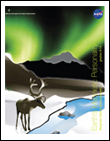Classroom Lessons - Grades 9 - 12
 |
Magnetism and Electromagnetism - is a review of basic magnetism, similar to what is encoun¬tered in most grade-level physical science texts. Students map field lines around bar magnets to visualize the magnetic dipole field, and create their own electromagnet using copper wire, battery and a pencil to learn that electric currents create magnetic fields. Two activities introduce gen¬erators and Lenz’s law, in one case using Earth’s magnetic field and a large conducting wire. These materials can be used by teachers presenting Earth and Physical Science courses in grades 6-9, and would fit well into a lab at the end of a high school physics class. These activities are a classroom-ready prerequisite to understanding magnetism on Earth and in space. Download an Acrobat version here - ( |
 |
Exploring Magnetism on Earth - is intended to help students explore Earth’s magnetic field through a variety of math-based activities. This guide contains problems focusing on Earth’s chang-ing magnetic field in time and space. Students use compasses to discover how these changes can impact navigation on Earth’s surface. They use basic math skills to interpret graphical information showing polar wander and magnetic changes, and answer questions about quantitative aspects of these changes. These lessons can be used in geology and astronomy classes. Download an Acrobat version here - ( |
 |
Magnetic Mysteries of the Aurora - is a prerequisite to using magnetometer data as students will in the next guide, Earth’s Magnetic Personality. Magnetic Mysteries of the Aurora introduces stu¬dents to Earth’s magnetic field and Northern and Southern Lights (aurora) within the context of the Sun and space weather. Using worksheets, globes, and a single light source, students review time-keeping on Earth—time zones and Universal Time. Students then go through a series of activities to discover the causes of the aurora and their relation to Earth’s magnetosphere and solar storms. Students classify images of aurora by shape and color, create a model of Earth’s magnetosphere, fore¬cast magnetic storms using geomagnetic indices, and engage in a presentation about space weather. These lessons have been used in physics and astronomy classes as well. Download an Acrobat version here - ( |
 |
Earth's Magnetic Personality - is the culmination of all the previous guides. It was developed with the goal that students can now work directly with the THEMIS magnetometer data. Students review vectors through calculations, learn to interpret x-y-z magnetometer plots, predict auroral activity using the x-y-z magnetometer data, calculate the total magnetic field strength and observe it over months, and discover that waves in Earth’s magnetic field are excited by large magnetic storms by comparing spectrograms with magnetic indices. Download an Acrobat version here - ( |
 |
The Northern Lights - This is a workbook of ten activities that explore the Northern Lights. The activities include essays, triangulation, parallax, geometry, calculator mathematics, graph analysis, prediction and forecasting. The link takes you to the original site that contains Word documents. Download an Acrobat version here - ( |



